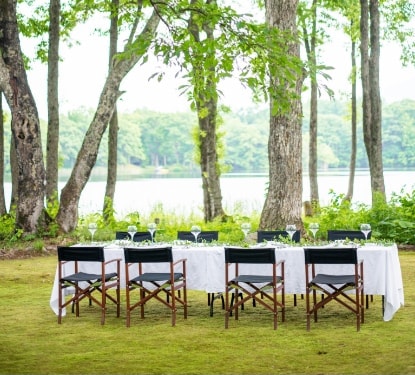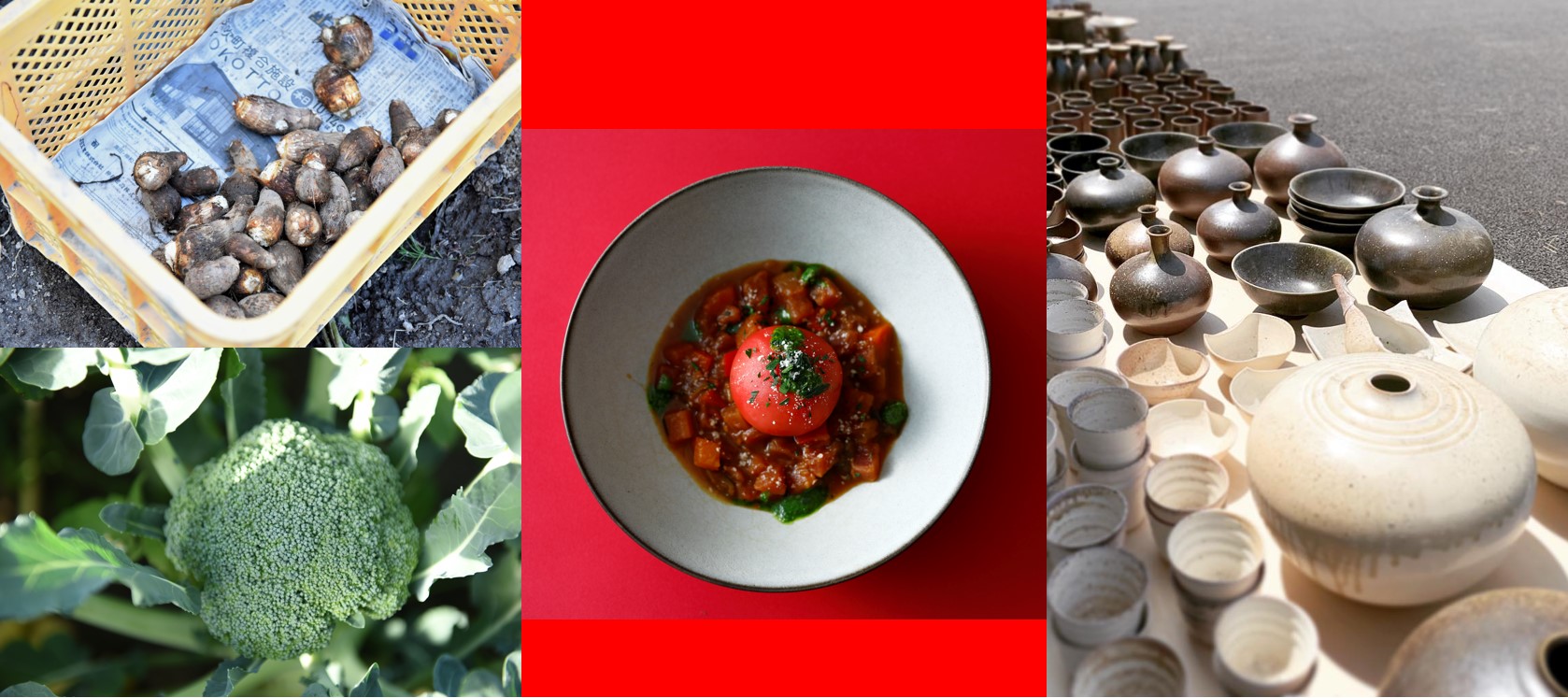
Nagatoshi Shiraishi of Farm Shiraishi can rightly be called the example of Iwaki’s energy. Not easily discouraged, and equipped with a carefree smile, his hardworking spirit is infectious. Chef Fukushima (Cross Wonder Dining) turns Shiraishi’s winter vegetables into a new genre, called ‘Wakan-Yosai.’ With the addition of father and son Manabu & Takashi Kondo from the Obori Soma-yaki pottery workshop Toukichirougama, with their unique philosophy, this edition of FoodCamp has a lot going for it!
Farm Shiraishi http://azuma-toyokuni.com/
Cross Wonder Dining https://www.cross-wonder-dining.com
Obori Soma-yaki Toukichi Rougama https://www.toukichirougama.com
Report
A meal of vegetables from rich soil
And there it was. The very last edition of FoodCamp’s 2022 season was a tour of Iwaki focussing on Farm Shiraishi, as well as Ohori Soma-yaki pottery.
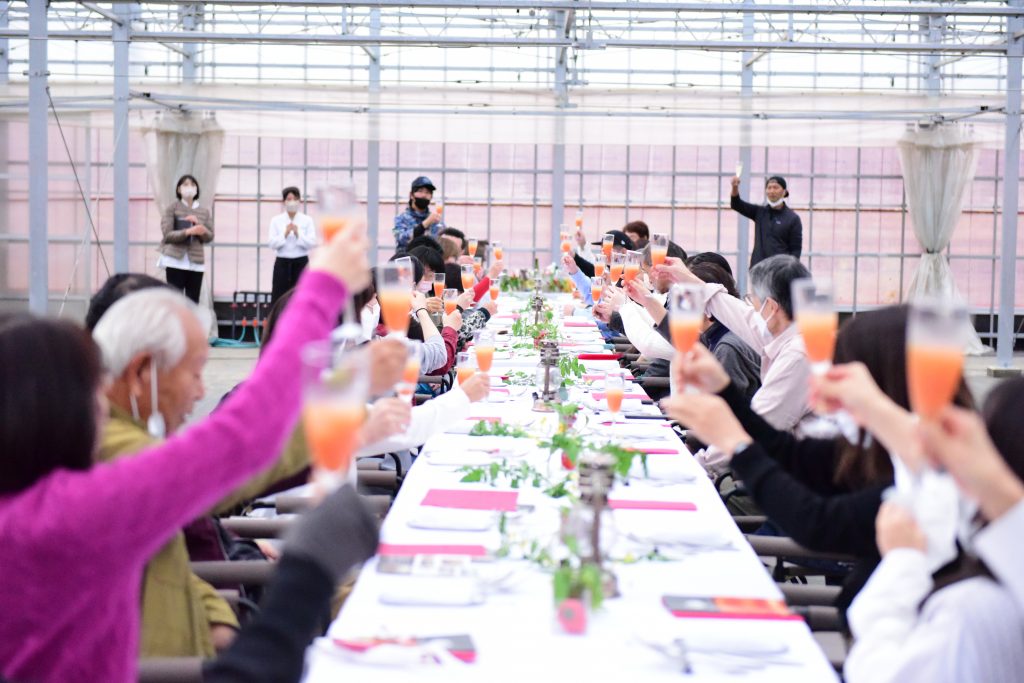
In 2019, typhoon Hagibis raged across Japan, bringing the Natsui River that flows near Farm Shiraishi to flood its banks, greatly damaging the farmlands. But farmer Shiraishi recognizes that this kind of disaster is also one of nature’s bounties, as well as a way for us to come to terms with mankind’s relationship with nature’s forces. Farmer Shiraishi is the head of a family farming business that has been growing seasonable vegetables such as sato-imo (Japanese yams), broccoli, spring onions, and pakchoi, using the shizen noho (natural farming)-method for centuries.
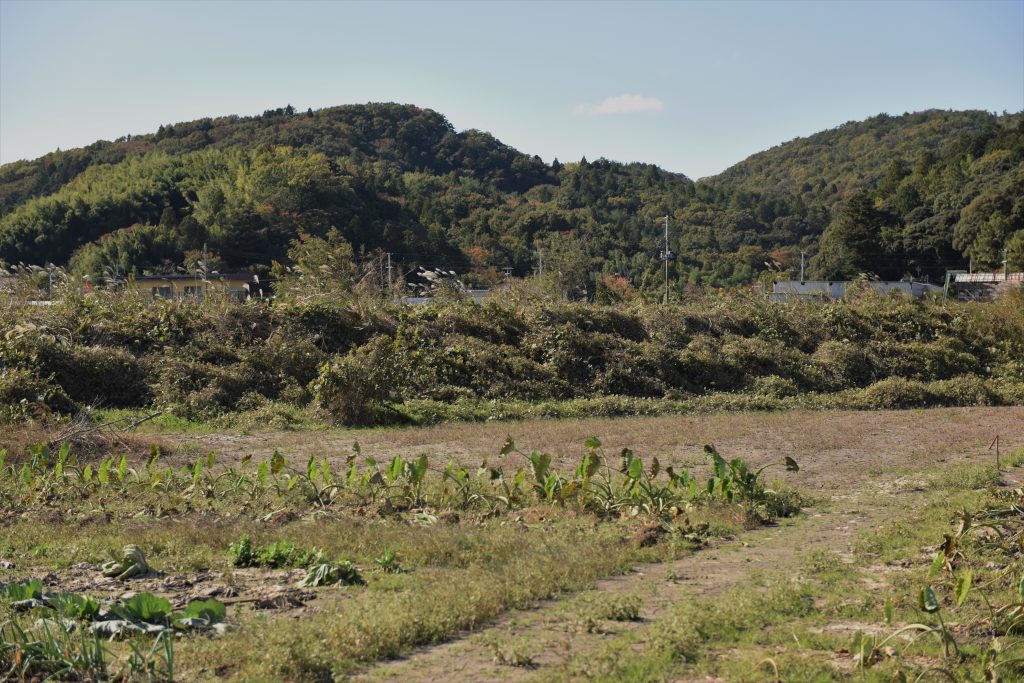
Farmer Shiraishi’s trademark is unmistakable: red. Just look at has red overalls, and his red truck. He’s difficult to miss, even from a distance.
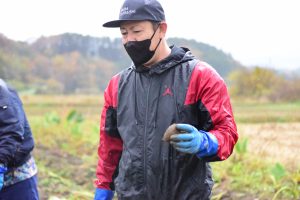
The first stop for the day is the Farm Shiraishi’s patch of sato-imo, named chobei. After the disaster of 2011, many crops were lost due to exposure to radioactive particles. But chobei sato-imo are buried so deep into the ground that they were able to avoid getting exposed. This way, a crop that had been grown here for more than a century was spared. For this reason, chobei-seeds were also incorporated into the Iwaski Mukashi Yasai (Iwaki Vegetables of the Past)-seedbank for preservation. They have an elegant umami-flavor and excellent water content, and their fine fibres make them silky smooth. This makes them a particularly popular ingredient of choice among professional chefs.
Although it was raining, it did not stop the group from going through with the harvesting class. Shiraishi uses a shovel to dig up the roots, and the guests pair up to get the potatoes out. The trick to getting the potatoes out from the lumps of hard, packed-up soil is to raise them up to waist-height, and let gravity do the rest by dropping them on the ground.
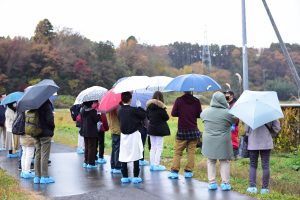
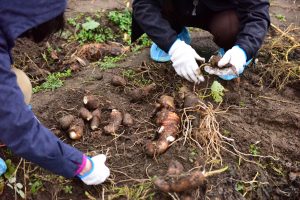
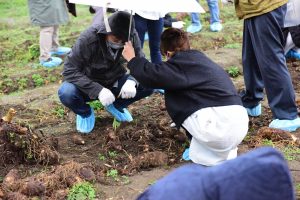
This naturally separates the little potatoes, making the work a lot easier.
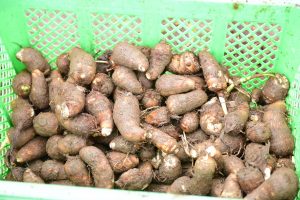
After brushing off the leftover soil, the yams are placed in a basket. As you can see on the photo, today was a good harvest. But as the rain got heavier, we decided to call it a day, and moved on to Farm Shiraishi’s greenhouse.
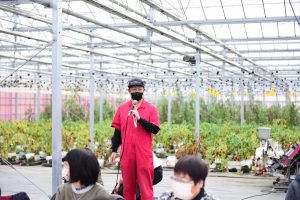
Shiraishi uses this greenhouse to produce red bell peppers. One area of the greenhouse was open, and available to be magically turned into our dining area for the day. As the greenhouse provides cover from the rain and wind, Shiraishi also uses it every once in a while for his own events.
Here, rather than in the rain, Shiraishi provides the guest with the background info on the cultivation process of chobei yams, and he takes the time to share his views and philosophies on farming.
In the meanwhile, the yams have been salted and after being boiled they are ready to be eaten. “You can eat them with skin on, you know.” The guests brave enough to give this a shot experience the real, gently aromatic taste of chobei-yams.
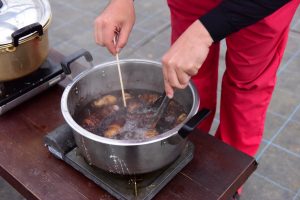
Time to introduce the next member of the main cast: Takashi Kondo, from Ohori Somayaki-pottery kiln Toukichirougama.
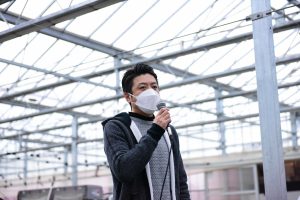
Toukichirougama was re-established by Kondo, together with his father, after the March 11 disaster. Kondo tells about his feelings at the time and the way he thinks about his pottery works.
“In the end, pottery is meant to be used. All I want is for the people using my plates at the dinner table to be happy.”
A festival of local ingredients
Chef Fukushima from restaurant Cross Wonder Dining at the Wonder Farm in Iwaki took on the job to provide today’s lunch menu. He moved to Iwaki 2 years ago for the restaurant’s grand opening. Although he is from Miyazaki, he is very fond of Iwaki’s produce: “Iwaki has so many great, fresh ingredients to offer, I have fun coming up with ways to use them in my cooking every day.” This is also why he didn’t hesitate to take up FoodCamp’s offer.
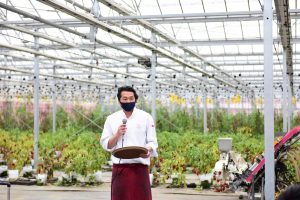
Today’s lunch is a modern French-style menu using plenty of Farm Shiraishi’s vegetables, based on Cross Wonder Dining’s concept of Wakanyosai (Japanese, Chinese and Western vegetables). When placed on Touchirougama’s beautiful plates, you get true works of art. Time to introduces some of today’s masterpieces:
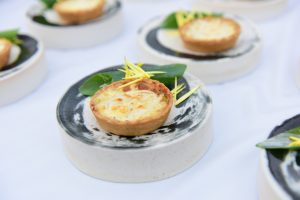
First up: a quiche of Farm Shiraishi’s spring onions, noodlefish from Hisanohama Harbor (Iwaki) and truffles. As you can see, it was presented on plates made by Takashi Kondo. Being wonderful to look at, the guests can’t help themselves from picking up and admiring the plates, adding a unique touch to this lunch.
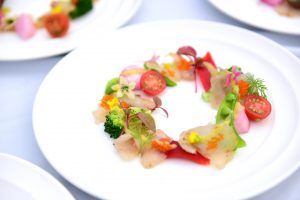
Next is a garden salad, with fish from Hisanohama Harbor, homemade raw ham, and vegetables from Farm Shiraishi. So close to Christmas, the gorgeous, wreath-like design was a real eyecatcher.
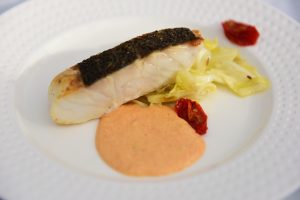
Next in line was a poêlé of flounder from Hisanohama Harbor, with braised cabbage from Farm Shiraishi and béarnaise sauce from Wonder Farm.
Perfectly prepared, the outside was crispy, the inside soft and fluffy. The combination with the tomato-based sauce was outstanding.
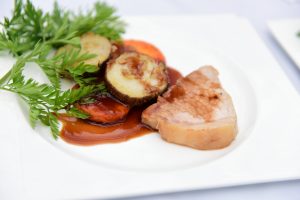
The meat-based dish was a roast of Abukuma-Kogen pork from Fukushima, with Farm Shiraishi’s chobei-yams and carrots in a bordelaise sauce. The softly-roasted pork, combined with the umami of the vegetables made it an excellent dish.
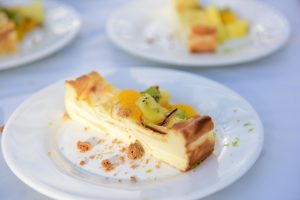
Baked cheesecake with lemon aroma
To close off this beatiful menu, was a dessert made with lemons from Farm Shiraishi. You could really taste how Iwaki’s bright sunlight had been soaked into the lemon.
The father-son duo pouring their souls into pottery
After lunch, it was time to move on to the next venue. Leaving the greenhouse behind, a Western-style house comes into view amidst the forest. It used to be a museum, but has since been renovated into what it is today: the Ohori Somayaki kiln Toukichirougama.

Touchirougama was formerly based out of the town of Namie, but was forced to relocate after the Great East Japan Earthquake in 2011, as the area was evacuated due to the nuclear power plant accident.
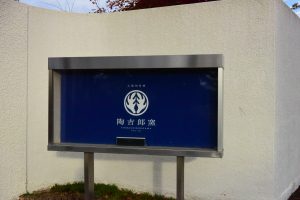
Takashi Kondo’s father Manabi is on-site awaiting the guests. Manabu Kondo’s works have received various national prizes, and he himself now serves as a judge for the Japan Contemporary Arts and Crafts Exhibition. His eyes reveal a glimpse of the passion of a true artist.
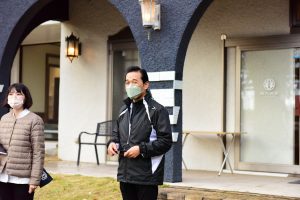
The guests get divided into two groups: Kondo Jr. gives a pottery workshop, while Kondo Sr. leads the group for a tour around the kiln.
At the pottery workshop, the guests get little balls of colored clay, which they can add together to form their own pottery pieces. Which colors and what kind of shape is completely up to the guests. Shaping the clay, imagining how it will turn out makes for a very fun experience.
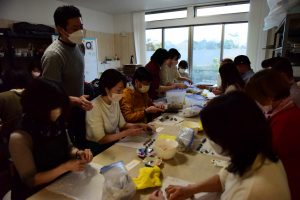
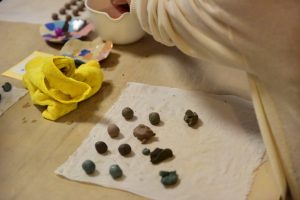
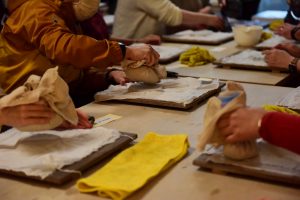
The pottery pieces will be great souvenirs for the participants, but they will have to wait until their done, in about 2 months’ time. We can’t wait to see the end products either!
During the kiln tour, the guests ask surprisingly insightful and technical questions, putting Kondo Sr. into full gear!
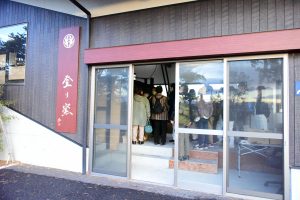
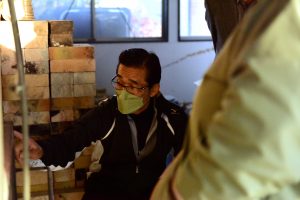
The so-called climbing kiln is a sloped space, divided into four rooms. The Japanese red pine logs used as fuel are heated to around 1200 degrees celsius. Kondo Sr. talks about how the temperature is controlled, how the charcoal forms the patterns on the pottery, and about to control the way the fire spreads through the kiln. Most surprising to the guests is the fact that to operate the climbing Kondo Sr. and Jr. take turns operating and controlling the heat for as long as a whole week!
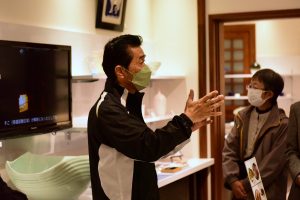
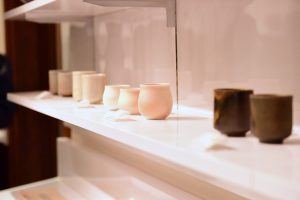
One more surprise from Kondo Jr.! He gets out the potter’s wheel to show the guests. “What should I make?,” he asks. “Make something amazing!” “Make the bowl you won a competition with!” The guests don’t waste the chance to put in some requests. With a bit of a wry smile, he says “Well, OK. Just this time then,” and proceeds to make a beautifully thin, delicate bowl. Just watching Kondo’s gentle, careful manipulation of the clay is entrancing to both the guests and staff.
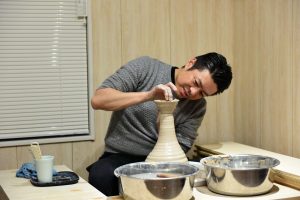
This was the first pottery experience for FoodCamp. How did you all like it? Both chobei-yams and Ohori Somayaki-pottery have been around for a long time, but there is something difficult to put into words about the traditions, and the passion for its continuation by those who have taken that upon themselves. All-in-all, it was a tour that make one feel that, no matter how much society advances, there are some things that don’t, and shouldn’t, change.
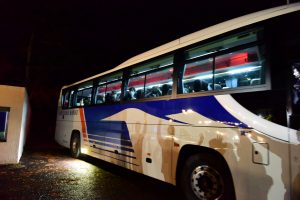
So much for the last FoodCamp of the year.
We are excited to see you again for the next FoodCamp season!
Highlights
-
Winter-vegetables Harvesting and Lunch at Shiraishi Farm
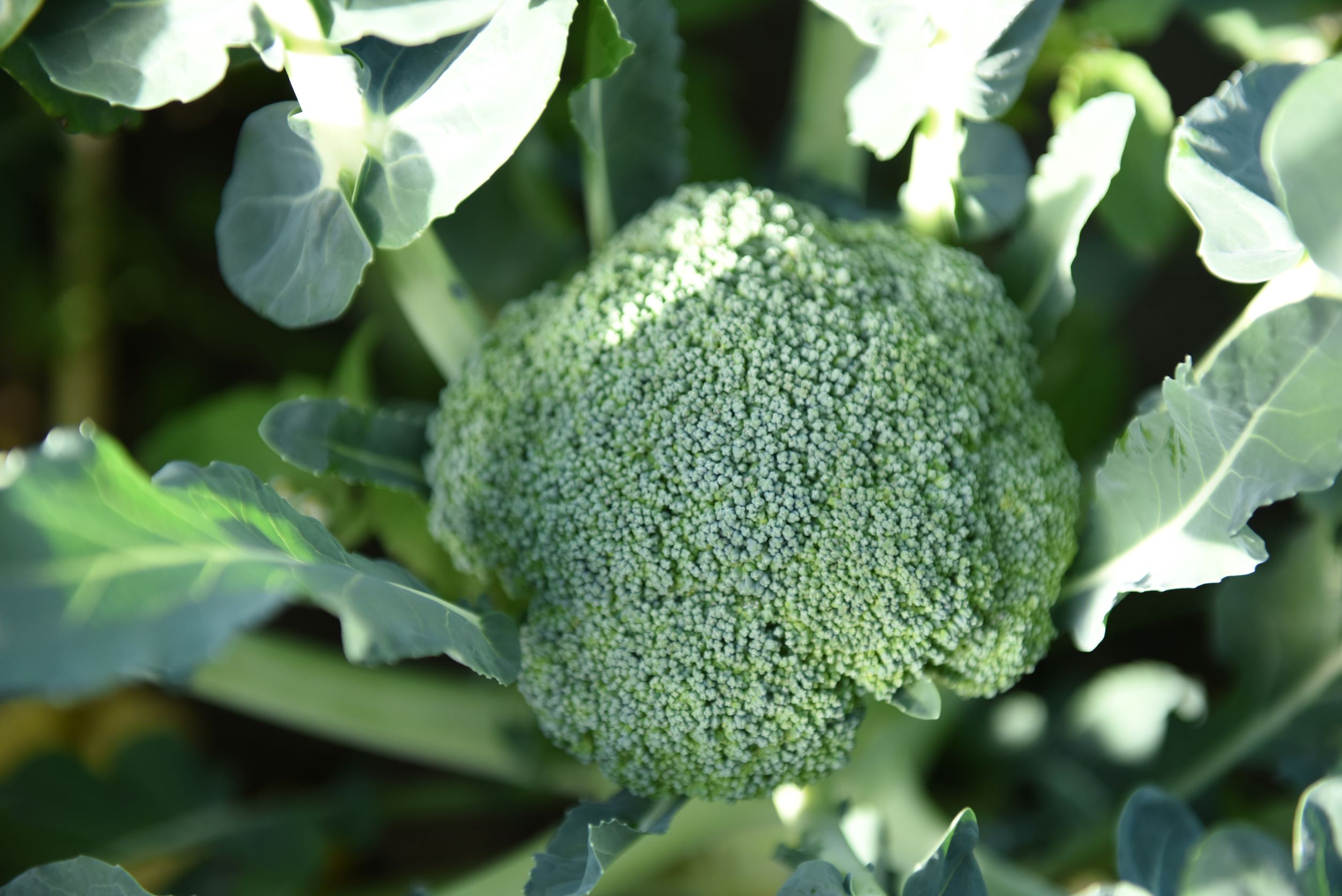
Harvest seasonal winter-vegetables at Shiraishi Farm, such as broccoli, onions, cabbage, daikon, carrot and napa cabbage, and in particular 'Chobei'-Japanese Taro, listed as one Iwaki's brand 'Mukashi-yasai' vegetables ('traditional-' or 'like old times' vegetables). Afterwards, enjoy lunch together with Shiraishi-san and Kondo-san at an exceptionally large greenhouse built after typhoon-damage of 2019.
-
Collaboration between Chef Fukushima (CROSS WONDER DINING)'s 'Wakanyosai' and Iwaki's Vegetables
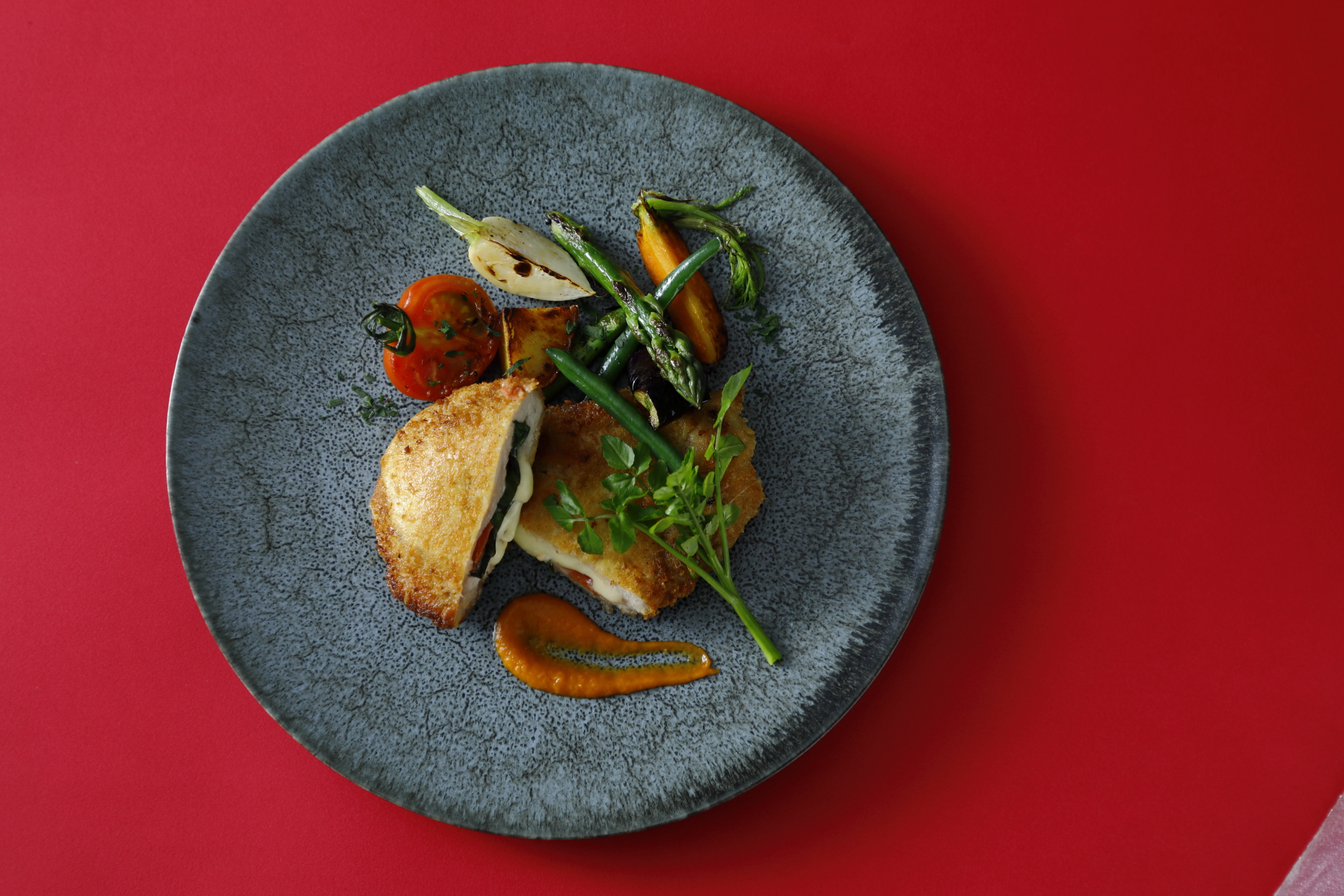
Learn about 'Wakanyosai' prepared at Cross Wonder Dining, the restaurant on the premises of Wonder Farm in Iwaki City. This edition of FoodCamp features a special collaboration with the vegetables of Shiraishi Farm.
-
Climbing Kiln Tour & Pottery Experience
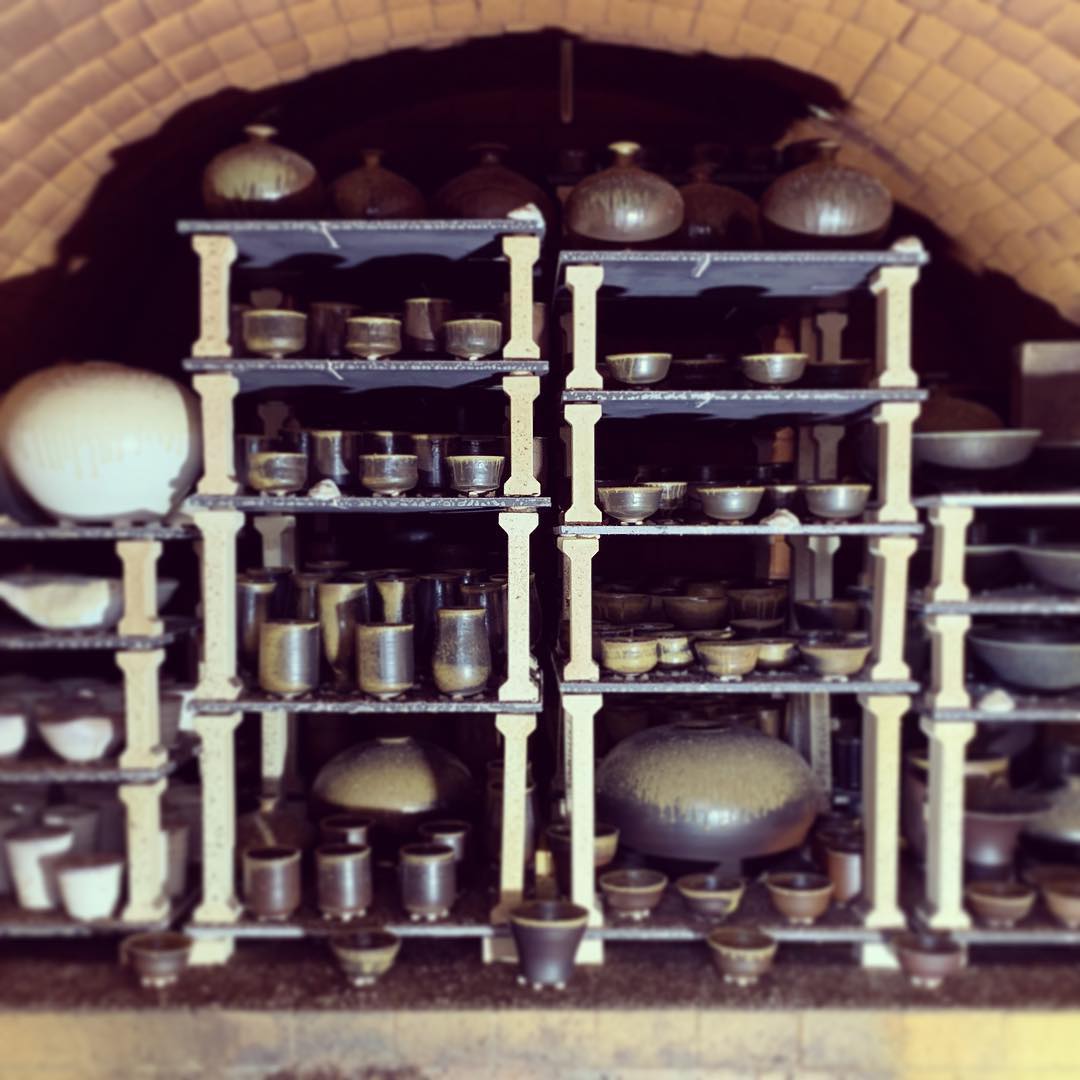
After the Great East Japan Earthquake, father and son Manabu & Takashi Kondo moved their Obori Soma-yaki pottery workshop 'Toukichi Rougama' from Namie ton Yotsukura (Iwaki), and continue to express and further develop the Soma-yaki craft with their own philosophy. Experience the beauty of Obori Soma-yaki through a visit to the rare climbing kiln, a tour of the workshop, and a pottery class.
Cast
- Representative, Farm Shiraishi Nagatoshi SHIRAISHI
- Sato-imo (Japanese Taro potatoes) of the Chobei-variety are registered in the Iwaki Mukashi-yasai seed-bank. They are named after Nagatoshi Shiraishi's father, in honor of the time they spent together growing potatoes.
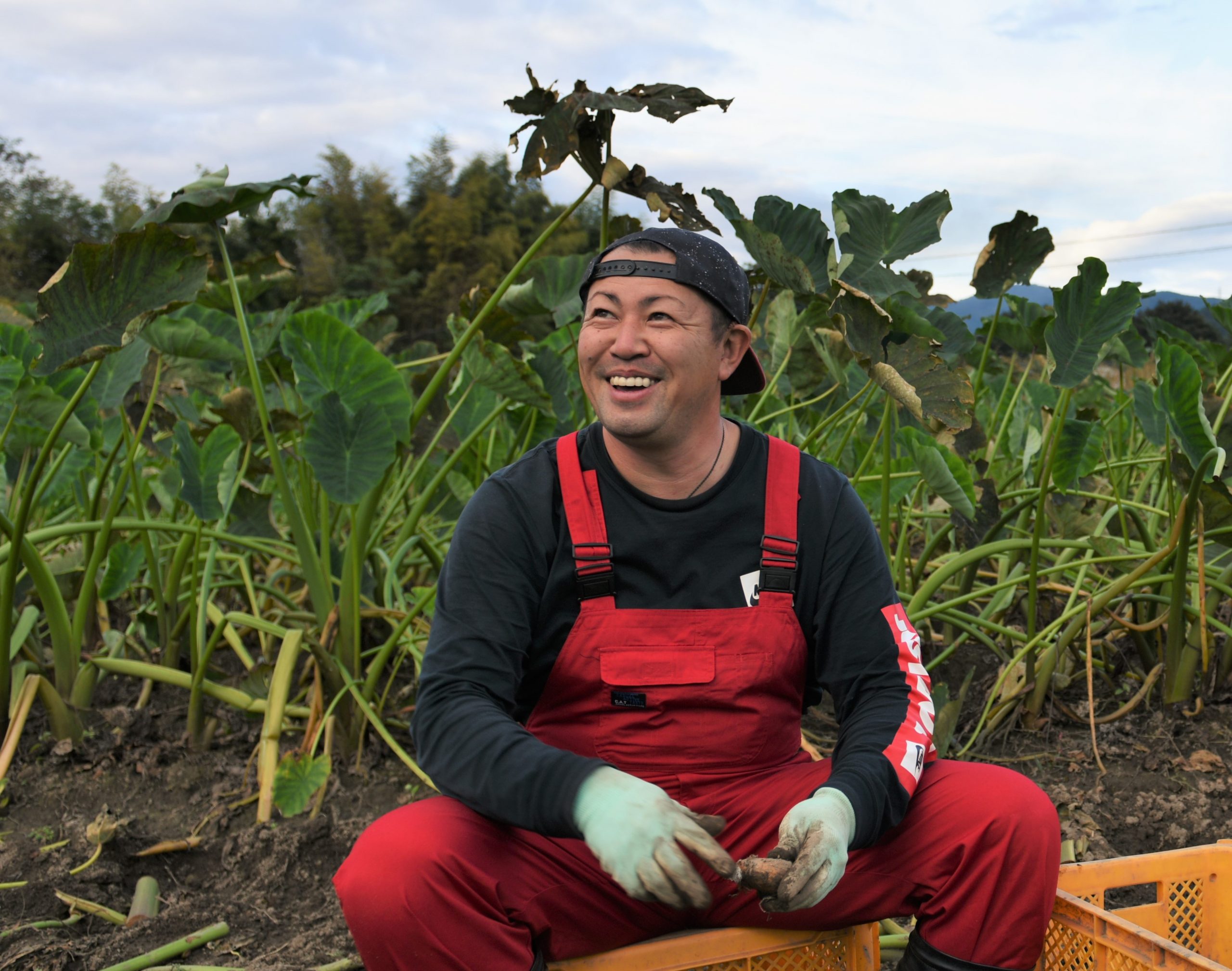
Protecting sato-imo for a hundred years
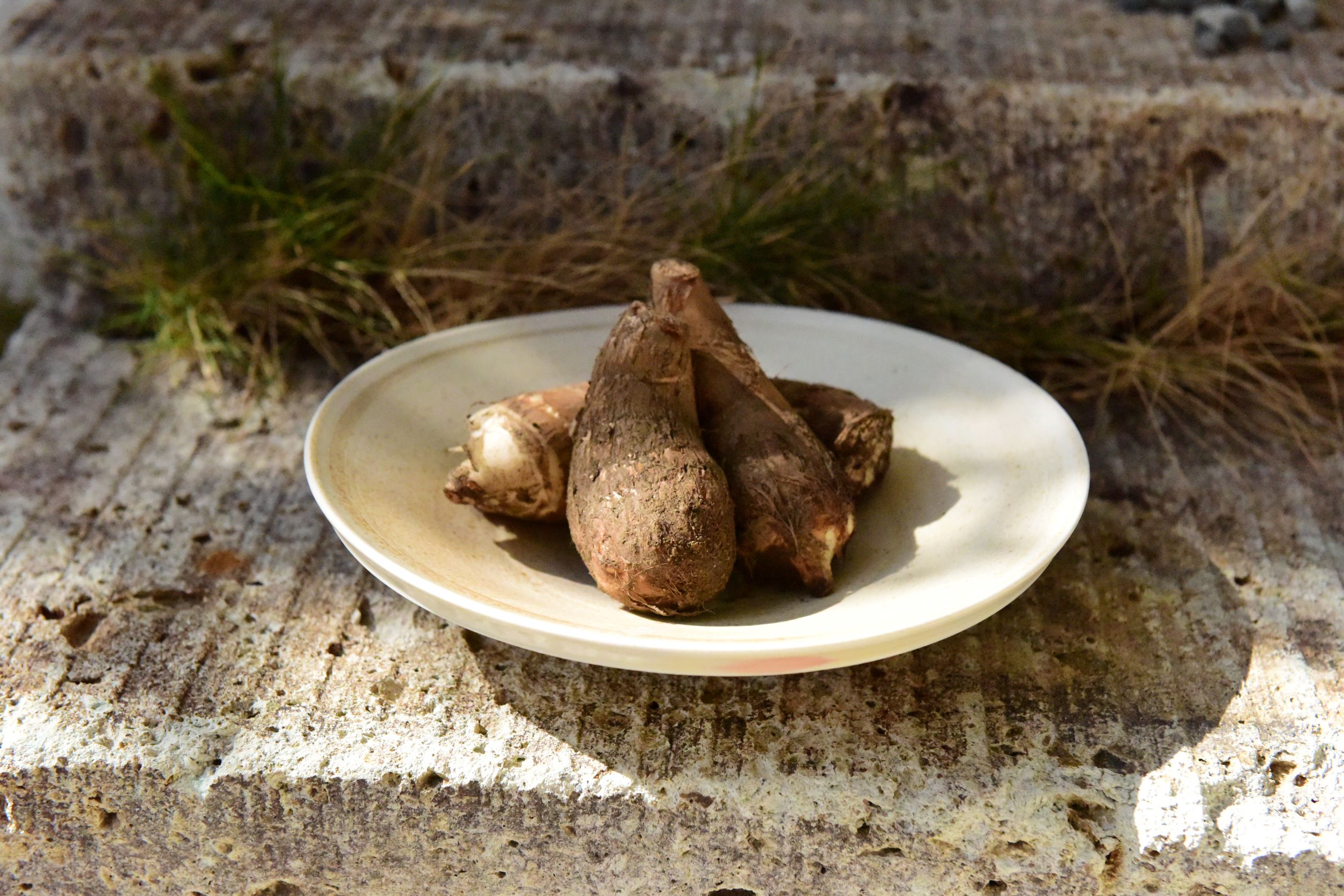
The Shiraishi family dates back to the Edo-period (between 1600 and 1868). Nagatoshi Shiraishi is the 8th head of this land-owning family. Besides sato-imo, they also organically cultivate several seasonal vegetables, such as broccoli, cauliflower, cabbage, carrots, daikon-root, napa cabbage, eggplants, rice, and Iwaki’s native ‘mote negi’-spring onions. After the typhoon of 2019 ravaged the area, many products were rendered impossible to ship. However, the sato-imo were saved by the fact that they were buried 1.5 meters deep, and covered by a layer of straw. After hearing this story, a chef recommended in 2016 to give a name to this native sato-imo species (which became ‘Chobei’), and register it in the Iwaki Mukashi-Yasai seed bank. Chobei was the name of Nagatoshi Shiraishi’s father. Naming this sato-imo after his father, is Shiraishi’s way of honoring the time they spent together on the farm growing them.
Natural farming, circular farming
Although Nagatoshi Shiraishi took over the family business at age 22, he had effectively been running it since he was a 2nd-year high school student. His father had fallen ill, leaving the farm business to his son. But shortly before his illness, Shiraishi Sr. had run into an expert on natural farming, and started studying it together with his son. The quality of the soil depends on the microbes that make it their home. These microbes allow for a natural cycle to occur in the soil. The microbes feed on organic material, and their excrement becomes nutrition for vegetables. Shiraishi knows all about this natural cycle within the soil, and has vowed to make sure it continues.
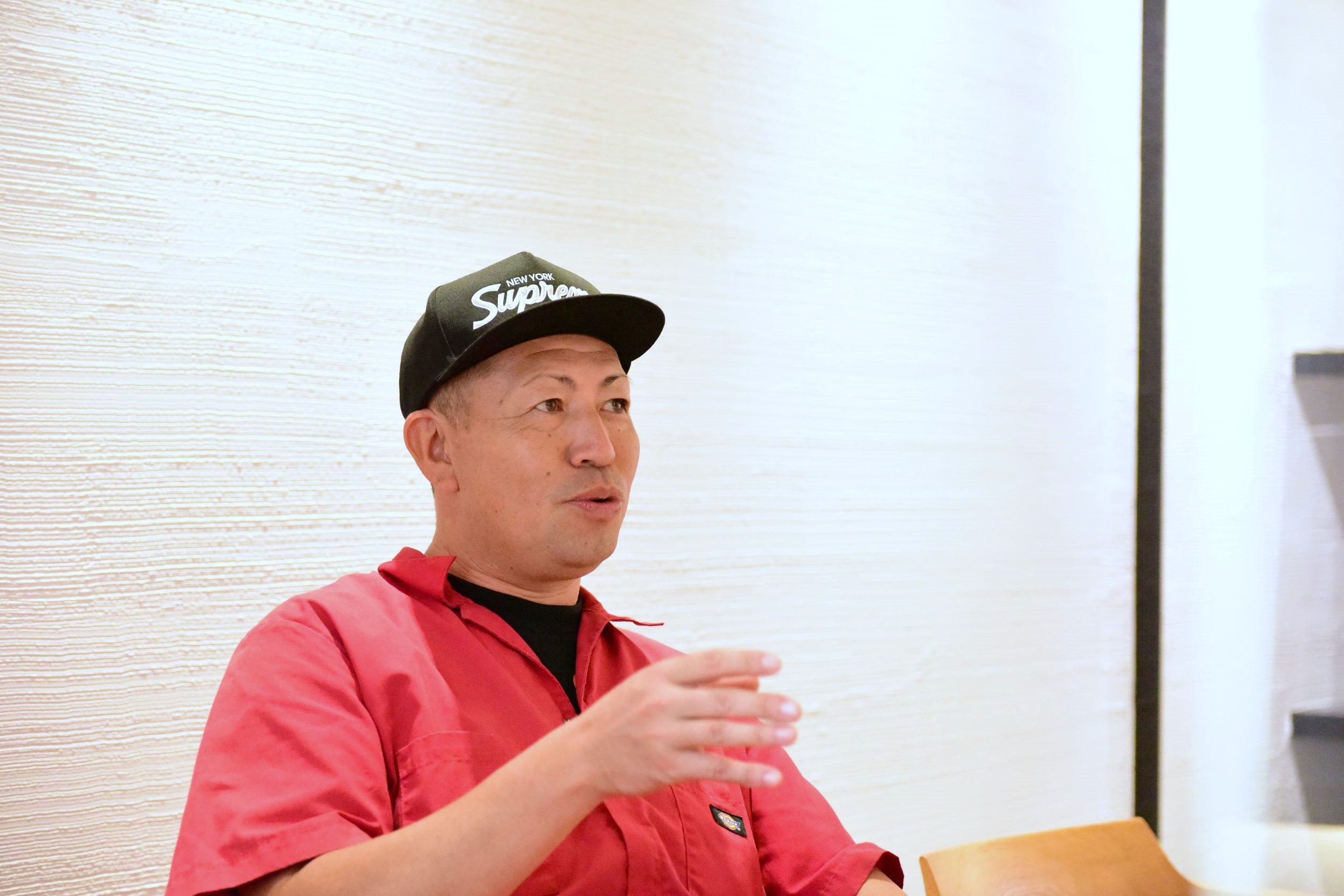
Overcoming the damage of the typhoon
In 2019, the nearby Natsui River overflowed, and spread 20-30 cms of mud over the farm fields. This caused many vegetables that year to be lost. The sato-imo, however, were safe, thanks to the fact that they are grown underground. Shiraishi acknowledges that these sato-imo, which survived the 3.11 disaster, as well as the 2019 typhoon, in the end saved him. The mud from the flood contained abundant nutritional content for plants, meaning Shiraishi hardly had to provide any organic fertilizer last year. “People consider these events disasters, but for nature it is really a matter of cleansing.” Shiraishi’s words ring true, especially spoken by someone with much experience with nature’s threats and bounties alike.
“I would have probably never become a farmer, if I didn’t happen to be born as one,” says Shiraishi, as he walks towards his farm field with a big smile on his face. The vegetables he grows are big in size, but also have an air of serenity.
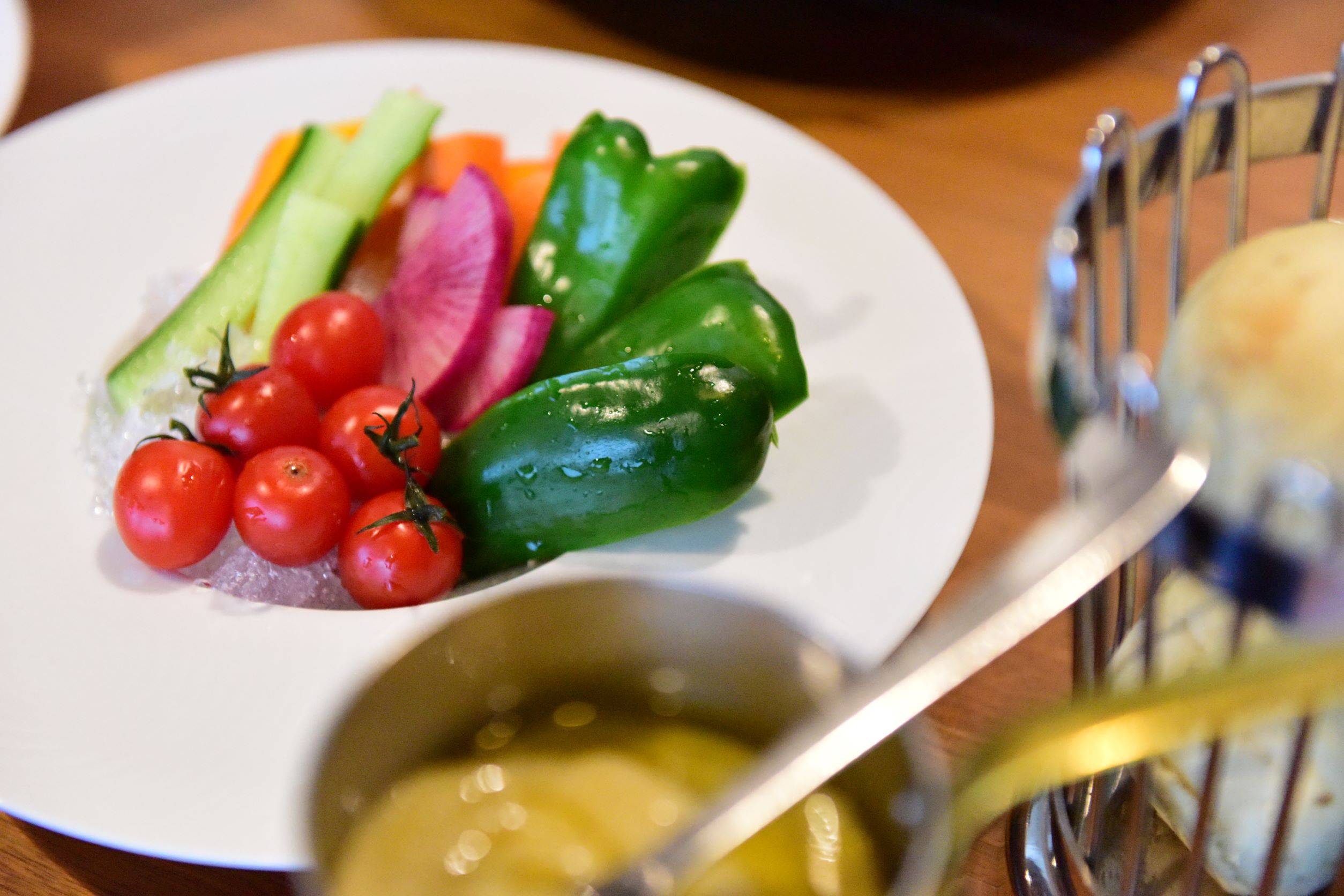
The greenhouse which had been destroyed by the typhoon, has been rebuilt, in time to serve as the dining location for the upcoming FoodCamp. Shiraishi is actively looking to use his greenhouse, usually reserved for farming, for other purposes as well. He’s always the first one to take one new challenges. Collaborating with father and son Kondo of Toukichirougama with their Soma-Yaki pottery, as well as Chef Fukushima of Cross Wonder Dining, is one more challenge to show off his diversity.
This is bound to be a very invigorating day indeed!
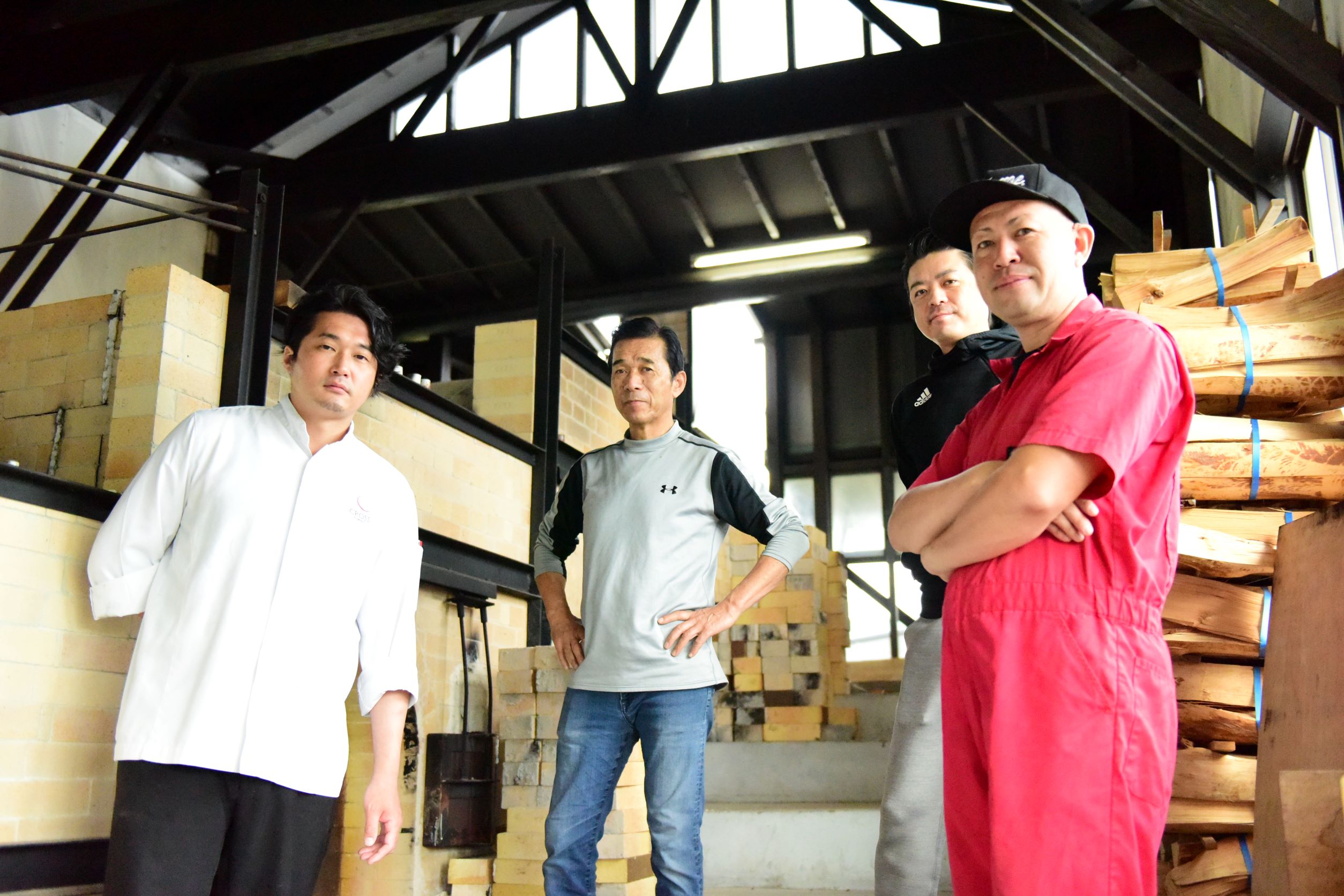
- Chef, CROSS WONDER DINING Nobuyuki FUKUSHIMA
- According to Chef Fukushima, 'Joban-mono' (fish from the sea near Iwaki) is firm, tasty, and well-sized. Mostly straight from sea to market, it's freshness is unbeaten. FoodCamp fits the chef's 'Crossing'-concept like a glove, making for a great opportunity to show off what Iwaki has to offer.

The ‘Crossing’-concept
Cross Wonder Dining, located on the premises of the Wonder Farm in Yotsukura, Iwaki, was established on the 12th of March 2021, 10 years after the disaster. It was started as the project for the next ten years of Cross Tokyo (a restaurant with strong social consciousness) together with Wonder Farm, which aims towards the recovery of the primary sector of industry in the areas affected by the 3.11 disaster with local producers and farmers.
The Crossing-concept means the crossing of people with people, rural with metropolitan, and producers with restaurants, to strive towards joint growth and contributing to the local community through a new kind of dining experience. Spearheading this project is Chef Fukushima, who studied French cuisine in Lyon and Burgundy.
When asked about the local ingredients of Iwaki, Chef Fukushima (who himself is from Miyazaki Prefecture in southern Japan) responds, “Joban-mono fish is firm , tasty, and well-sized.” It means a lot coming from a chef who’s worked with som many great ingredients over the years. He adds, “The ingredients you get in Tokyo have usually been shipped for two or three days. Here at Cross Wonder Dining, we use fresh ingredients directly from the farmers and fishers, which is what makes the restaurant so great.”
Tomate Gastronomie and Wakan-Yosai
One of the most attractive features is the ‘Tomate Gastronomie‘-project, undertaken with the adjacent Wonder Farm’s tomatoes. The tomatoes grown at the Wonder Farm all year round, are served in many different ways, showing off the chef’s knowledge of- and skill with tomatoes.
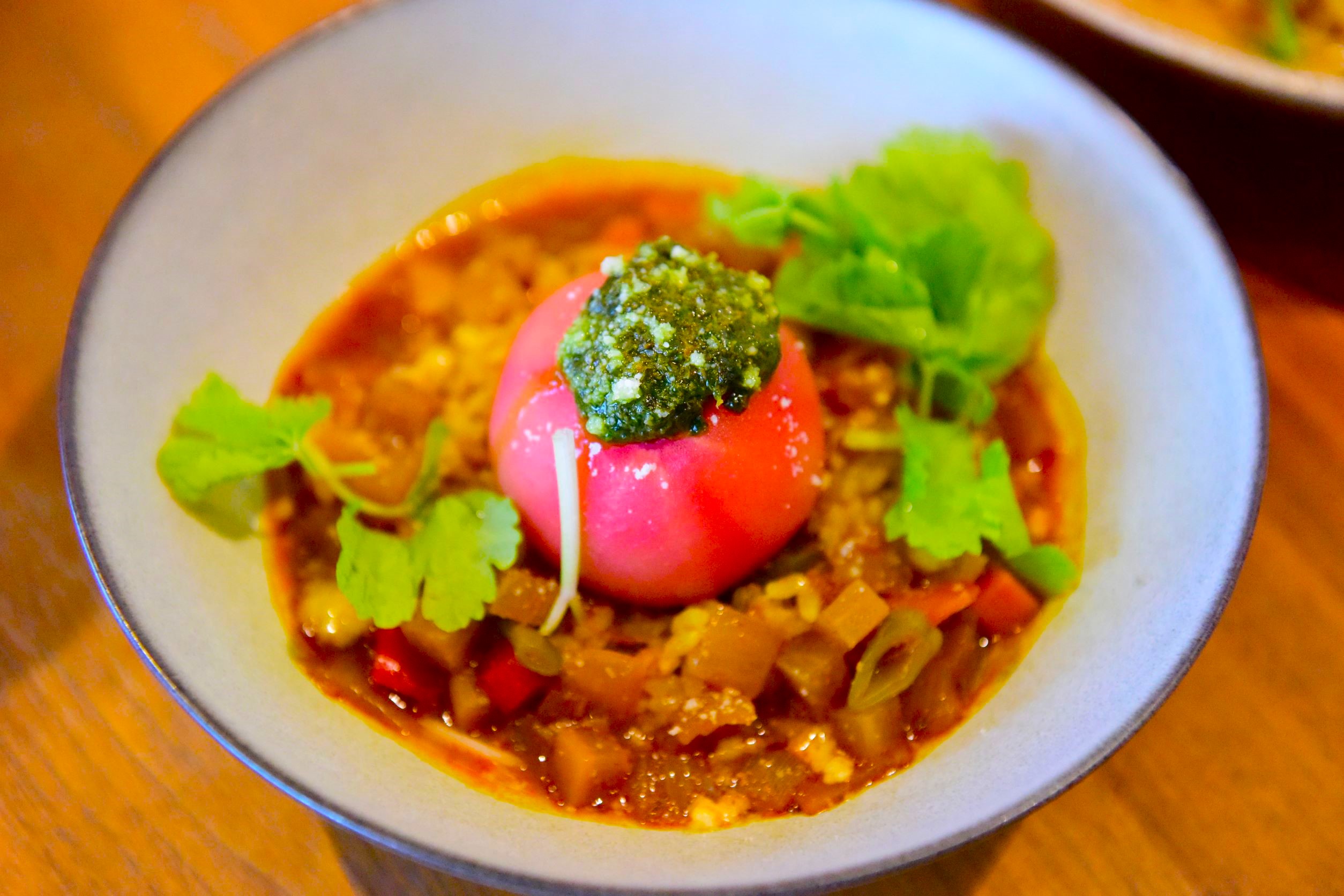
Cross Wonder Dining is also an advocate for another style of unique and original cuisine called ‘Wakan-Yosai.‘ This is a healthy fusion of Japanese-, Chinese and Modern French cuisines, but inspired by traditional Chinese medicinal cooking, e.g. the skillful use of herbs and spices, as well as traditional Chinese-and herbal medicine, and a good balance between vegetables, fish and meat. The drink menu also regularly features – besides beer and wine – various carefully selected alcohol beverages with medicinal benefits, and kanpo-cha (traditional Chinese medicinal tea).
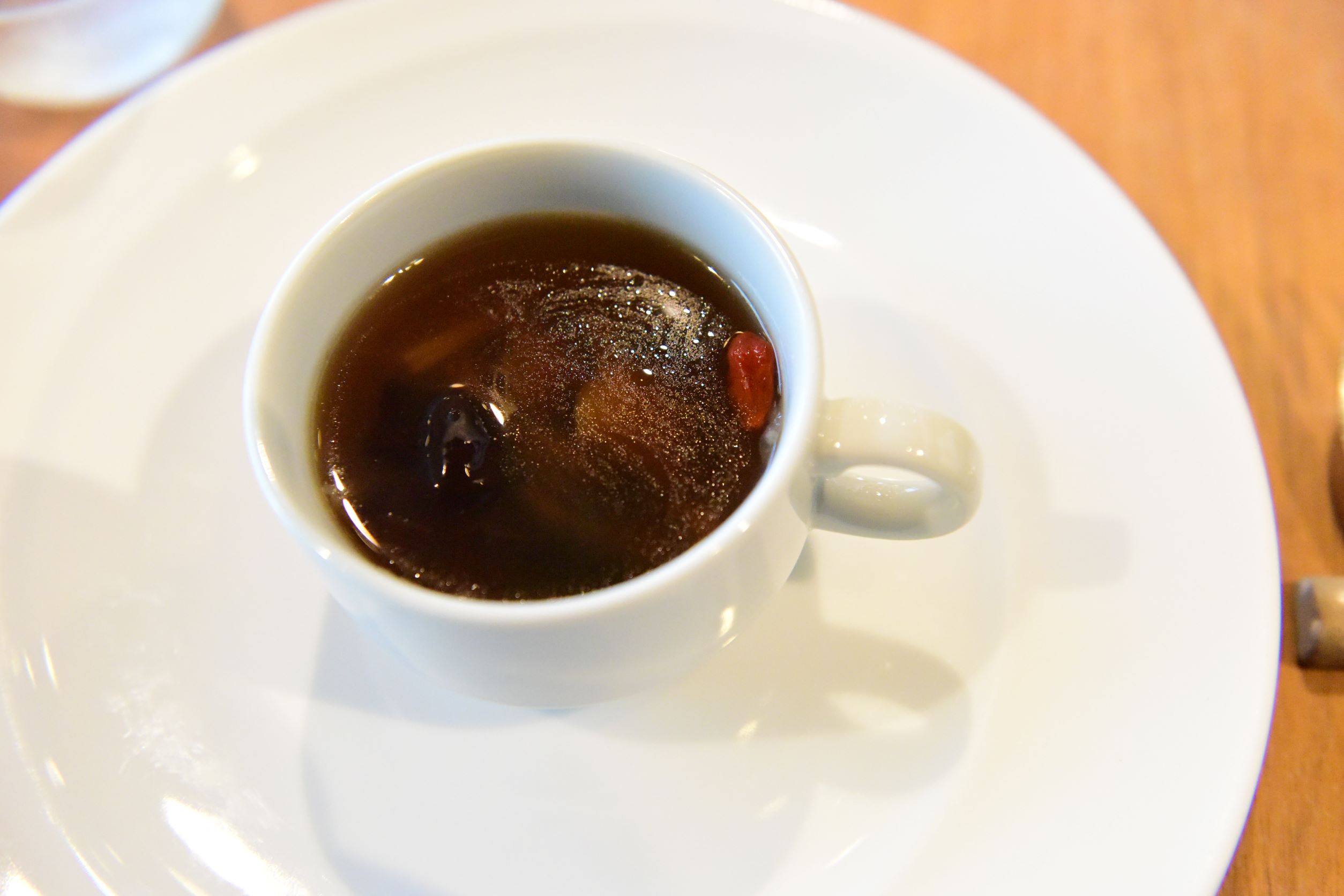
The wonder of ‘meeting’
There are stories behind the chef’s first meeting with this edition of FoodCamp’s producers. He is now well-acquainted with the farmer of sato-imo and other fresh vegetables Shiraishi, as well as father and son Kondo of Ohori-Somayaki pottery kiln Toukichirougama, who moved to the area from the town of Namie after the disaster. Chef Fukushima has been using Shiraishi’s vegetables, as they are relatively large in size, and have a sort of serene quality to them, according to the chef. The character of the farmer comes through in the product.
As for his meeting with the Kondo’s, one night Kondo came to the restaurant, carrying a plate. He told the chef that he wanted to organize a dining event at the restaurant, using the craft plates from Toukichirougama. Of course, the chef was on board right away. This is the power of the meeting of kindred spirit, which is what led to their current relationship.
This kind of meeting might just be the best kind of spice Iwaki has to offer. It has led to a kind of flavor that’s hard to pin down. But doubtless, the world of Cross Wonder will be revealed during the upcoming edition of FoodCamp.
- Obori Soma-yaki Kiln 'Toukichirougama' Manabu & Takashi KONDO
- Kondo Jr. (Takashi Kondo) always looked up to his father Manabu as a craftsman, bearing the long history of Obori Somayaki-pottery. We are fascinated by the world this father and son duo of the Toukichirougama kiln shape.
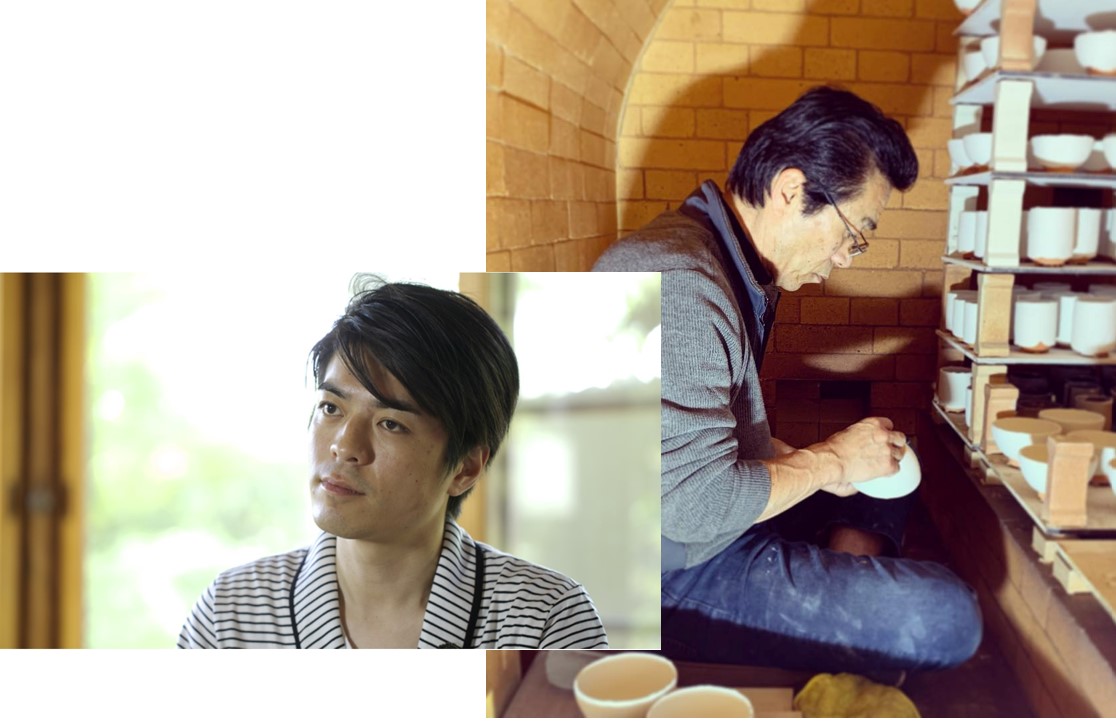
Toukichirougama and the history of Obori-Somayaki pottery
Around 300 years ago, Obori Somayaki pottery developed in the Obori area of Namie Town, supported by local farmers who learned the craft of pottery, looking for a new way to create a future for themselves as artisans. In order to prevent the loss of technology to other areas, the local government in 1697 proclaimed that Obori Somyaki artisans were not to leave the region. The art slowly spread out to neighboring towns, and by the end of the Edo Period (mid-20th century) the area has become the foremost producer of pottery, with around 120 kilns. But the subsequent Meiji-period saw a move towards other industries, and the pottery industry came into rapid decline. The Great East Japan Earthquake disaster, finally, caused most kiln-owners to leave the area.
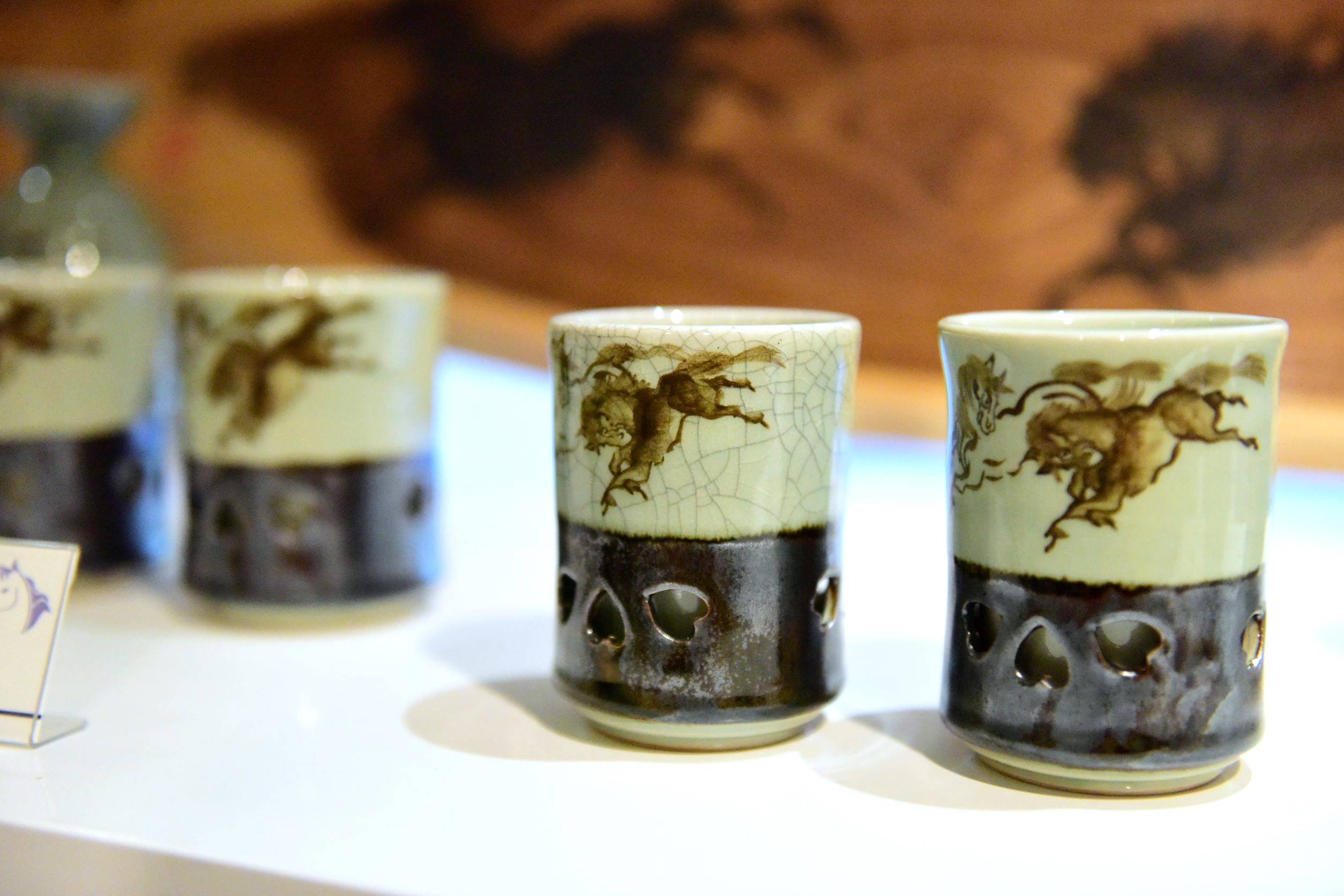
The first head of the Kondo-family, Heikichi Kondo, learned the kyo-yaki and rakuyaki crafts and became an artisan in Edo (the former name of Tokyo). In 1777, he was requested to move to the Aizu Domain (now western-Fukushima Pref.), as a pottery instructor. Next, he moved to the domain of Miharu (now in central Fukushima), where he taught the craft to hundreds of students. His son, Toukichi Kondo, after Heikichi’s death, continued for some years in Miharu, before settling down in the Obori-area in the Soma-domain, near the coast. This spirit has been passed down to 9th generation family head Manabu Kondo, and his son Takashi.
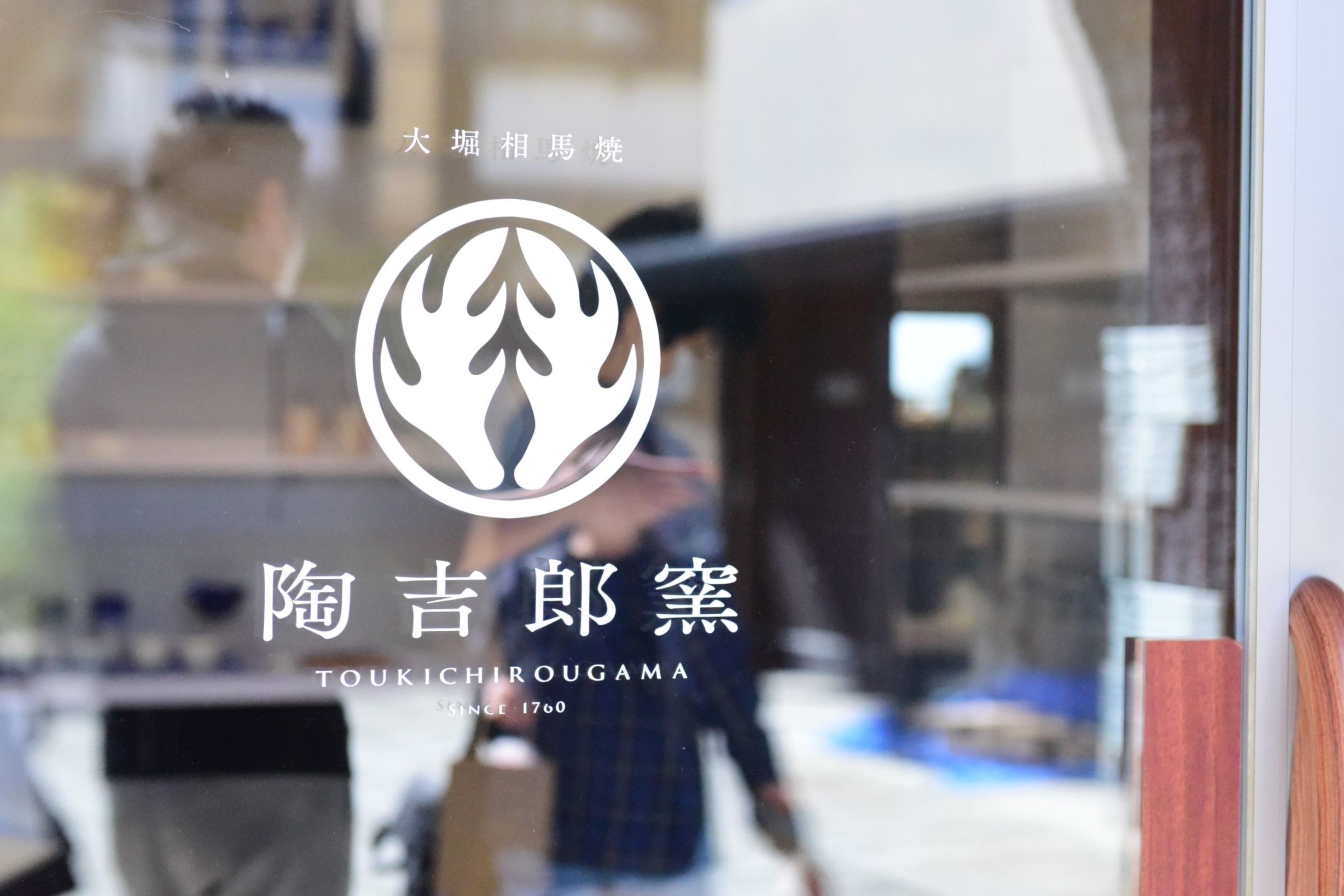
Thanks to the connection with a certain customer, Kondo Jr. and Sr. managed to set up a new kiln in their current location, after the Obori-area of Namie Town was designated as a ‘Difficult to return-zone’ after 3.11. Their first big task was to recreate a so-called ‘climbing kiln’. A climbing kiln is a type of kiln in which – in order to produce pottery in large volume – the furnace is divided into several spaces, which all us a slanted surface. Since the Obori-Somayaki kiln was first established, it had always used Japanese red pine trees as fuel for the climbing kilns. Since the 1960s, this practice started to die out with the induction of gas-, kersone- and electric kilns. But in 1988, Toukichirougama revamped their climbing kiln, to create new pottery in it every spring. This climbing kiln is in use for over a week, during which time it has to be replenished with firewood constantly. This hard work is part of the craftsmen’s identity. It has now become a symbol of the spirit and dignity of this Toukichirougama and its climbing kiln, even after the transition to a new land.

My father, the craftsman
After Manabu Kondo graduated from college, he started working for the family business, the Obori Soma-yaki Kiln Toukichirougama. At 28 years of age, he was first selected for a national modern craft exhibit, and kept being selected, until at age 32 he was selected for the Japan Fine Arts Exhibition. It was the first time a craftsman of Obori Soma-yaki was selected. Afterwards, he became a regular face and winner at various exhibits and competitions, even becoming a judge at the Japan Contemporary Arts and Crafts Exhibition.
In 2012, at age 58 he was held in such high regard in-and outside of Japan, that he was featured on Italian fashion brand GUCCI’s official blog, as a one of Japan’s most representative potters.
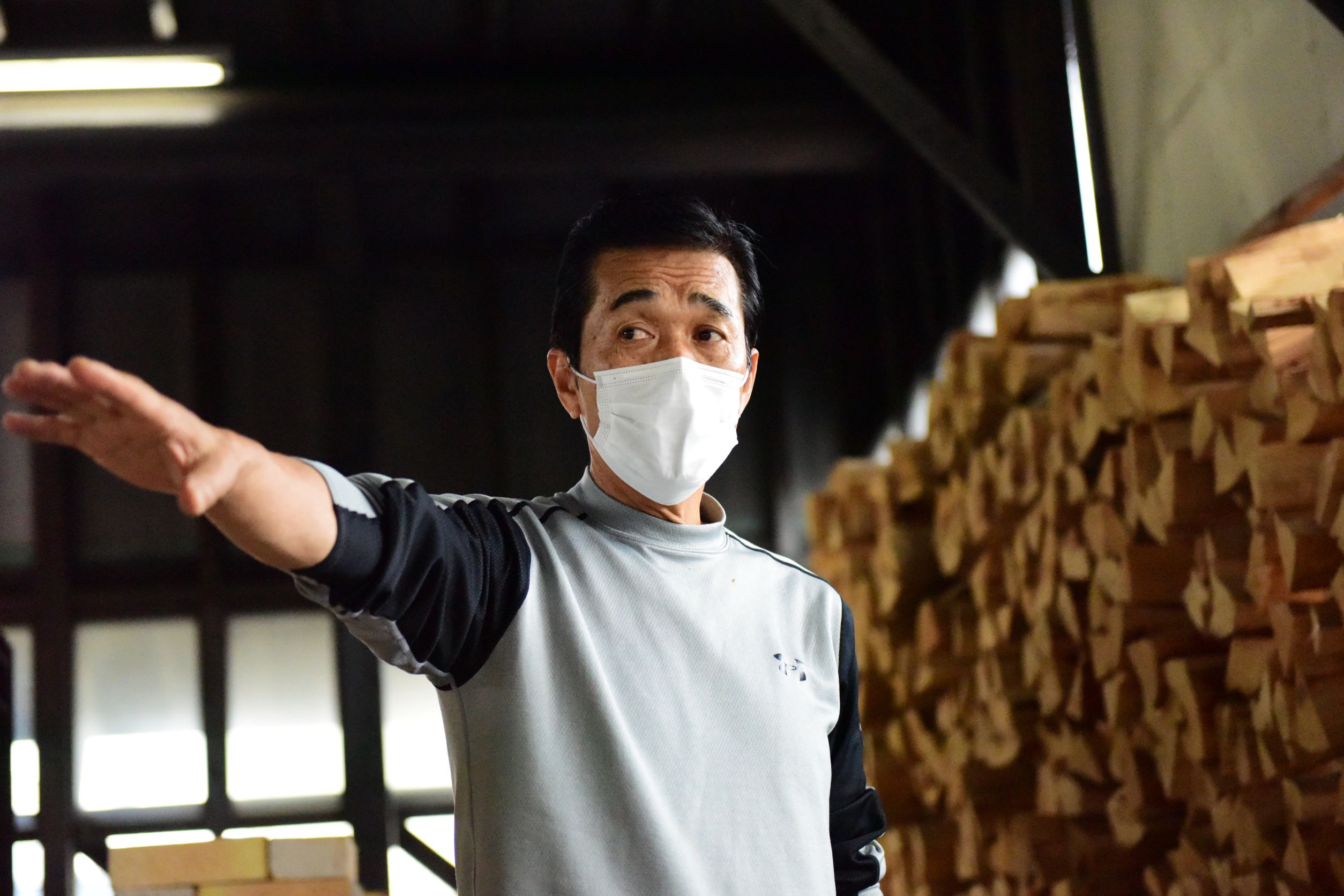
How must it have been for his his son, Takashi, to grow up seeing this?
Even though he is the oldest of three sons, Takashi Kondo was never pressured into becoming a potter and taking over the family business. But the desire to become one developed inside him at an early stage. He says, “That was mostly thanks to seeing how much my father enjoyed his work.”
Takashi followed through on his dreams, and entered into an arts college, majoring in pottery. As a college student, he started making his first works. Takashi, at 21 (an even younger age than his father) was first selected for the Japan Fine Arts Exhibition and won. Afterwards, he won various other art prizes, incl. Toyota’s LEXUS NEW TAKUMI PROJECT.
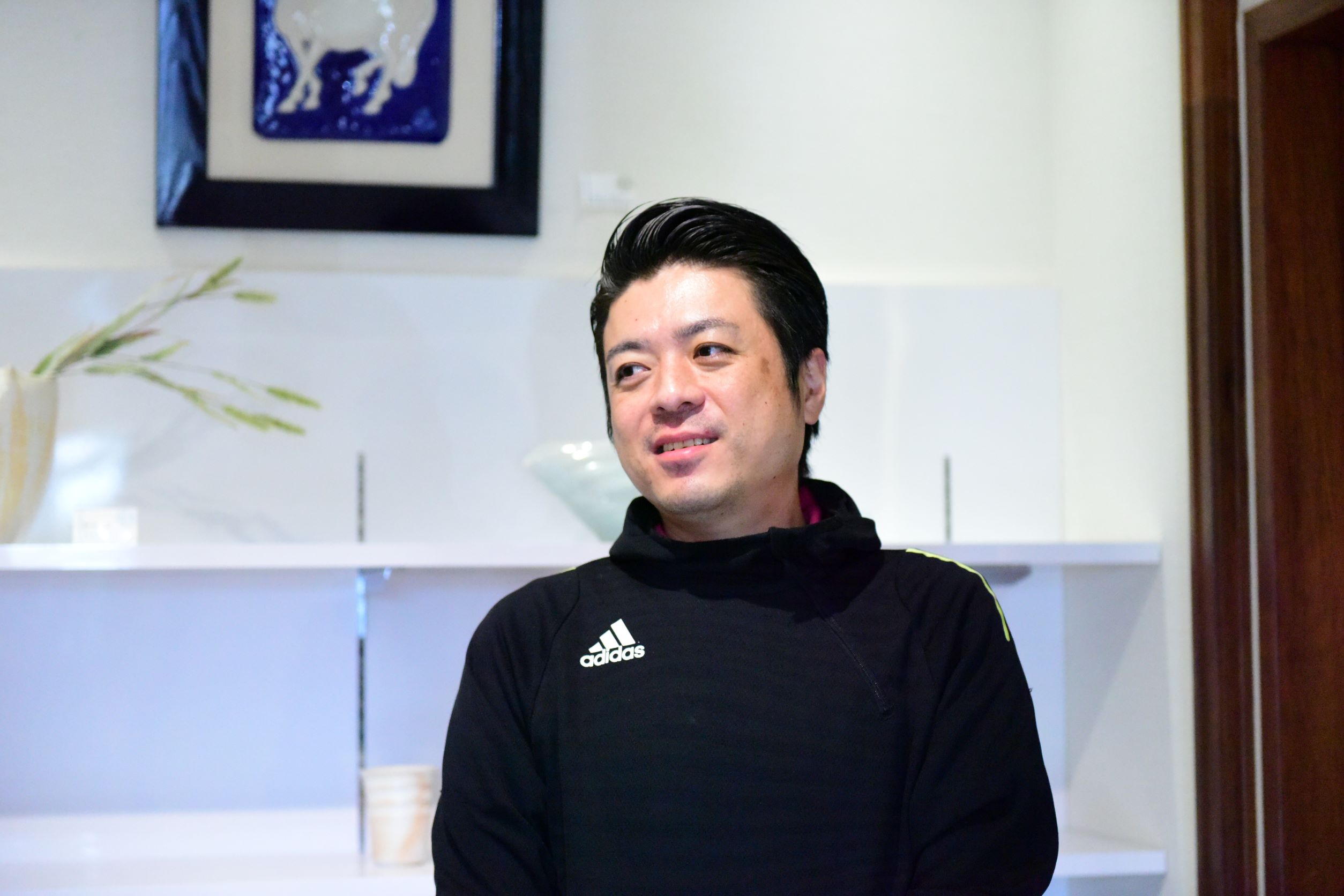
The success of this father and son is truly spectacular. We, at FoodCamp, were astonished to learn that craftsmen like these are active and living in Fukushima. Their styles are radically different from one another. But that’s to be expected from craftsmen, as they are after all artists in their own right, besides being father and son.
How do these two outstanding craftsmen regard FoodCamp?
“Even though we’re potters, we’re interested in trying many different things. We want to create new opportunities,” says Takashi. His father, realizing that their works were never used in restaurants, took it upon himself to find a professional chef who would be interested to cooperate. FoodCamp offers the perfect chance to create a new precedent. At FoodCamp, we couldn’t be more proud to start the collaboration we these amazing artists.
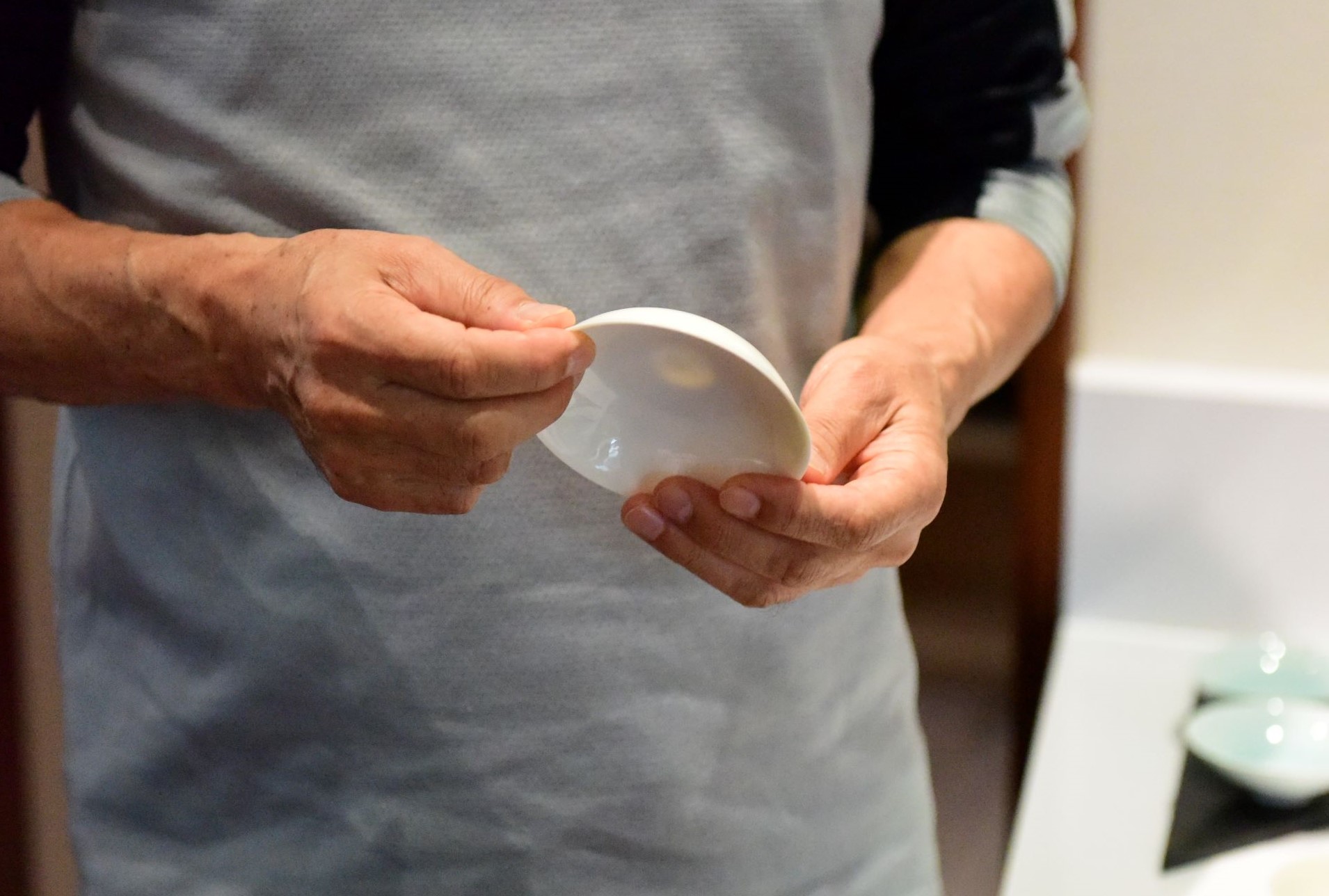
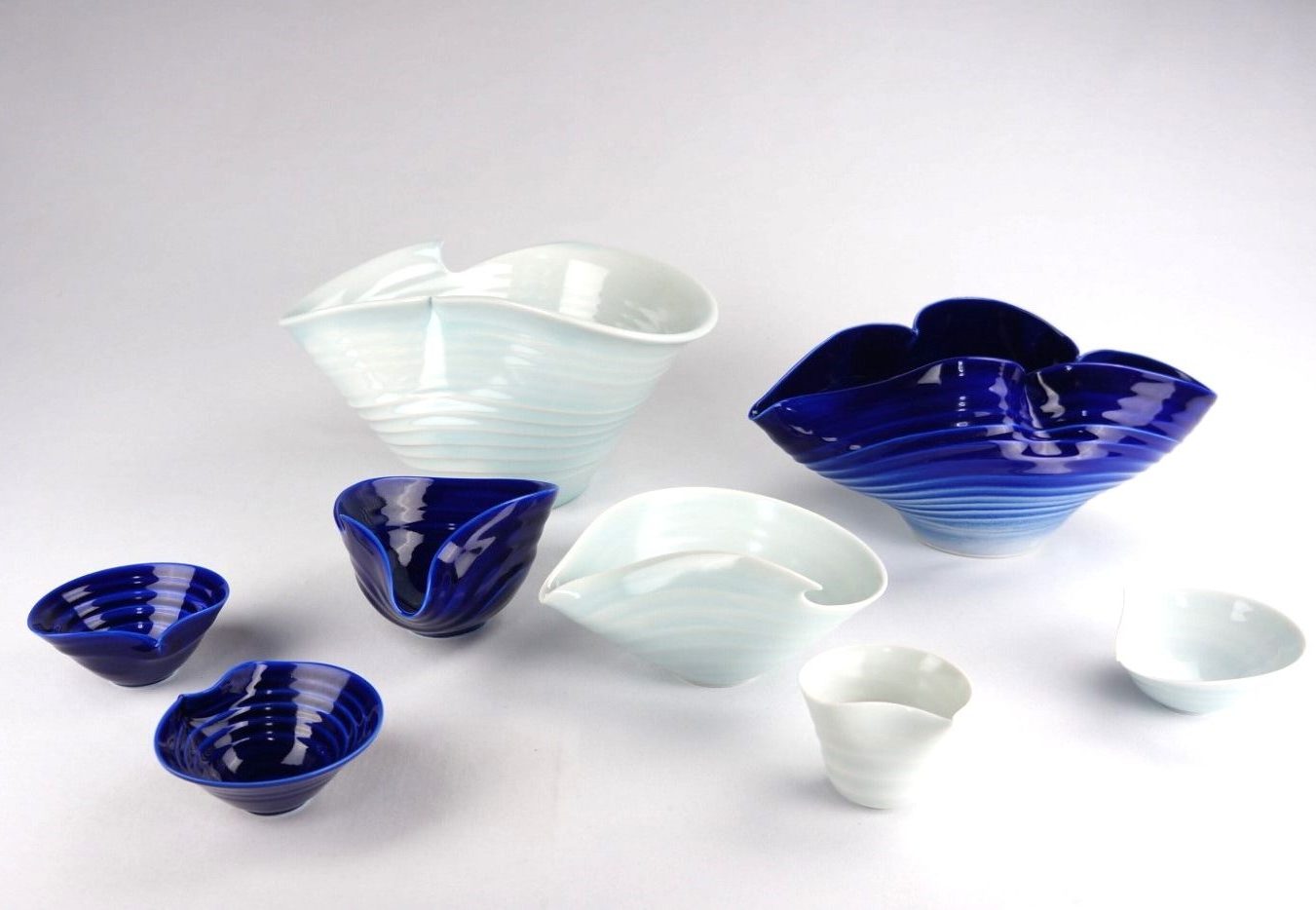
Tour details
- Date(s)
- November 26 (Sat.)
- Fee
-
*same rate applies for children/participants travelling to the venue directly with their own vehicle.Per person ¥17,800 *same rate applies for children/participants travelling to the venue directly with their own vehicle. - What to wear/bring
- ・This tour takes place outdoors. In case of clear skies, please prepare a hat or cap to protect you from the sunlight.
・Please wear comfortable shoes and clothing.
・In order to prevent the further spread of COVID-19, please wear a mask. - Conditions of Participation
- Participation open to everyone over elementary school-age, and able to participate on their own (no need for accompaniment by a care helper, or with permission from a doctor). Same price for adults and children.
- Operating Company
- Koriyama Kanko Kotsu K.K.
- Tour Operator
- Magonote Travel's own staff will accompany the tour.
- Payment Method
- Please refer to "How To Apply" for more information.
- Travel Insurance
- Travel insurance is required for all tours, in case of accidents and emergencies. The insurance fee is included in the price. For this reason, we need to ask for your date of birth.
- Cancellation Fee
-
The following cancellation fees will be charged for tours with lodging and tickets: 20 to 8 days in advance: 20%, 7 to 2 days in advance: 30%, the day before the tour: 40%, on the scheduled date before the tour starts: 50%, no-show without notice: 100%.
For one-day tours, the following fees will be charged retroactively from the day before the start of the tour: 10 to 8 days in advance: 20%, 7 to 2 days in advance: 30%, 1 day in advance: 40%, on the scheduled date before the tour starts: 50%, no-show without notice: 100%. - In case of bad weather
- The tour will not be cancelled in case of bad weather. However, in case the tour has to be cancelled due to a natural disaster, you will be informed one day before the tour. In this case, you will receive a full refund.
- Minimum number of participants
- If there are fewer than 15 participants the tour will be cancelled. In such case we will inform you at least 4 days in advance.
- Terms and Conditions of Travel
- Please visit the ‘Terms and Conditions of Travel'-page.
- Other points of caution
- In order to prevent the spread of COVID-19, we ask all guests to fill in a health-check form beforehand. We will send you the details after we have received your application. Thank you in advance for your cooperation.






